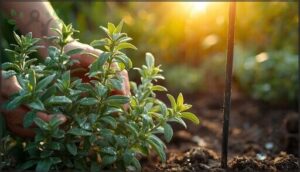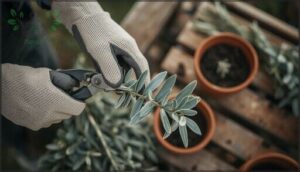This site is supported by our readers. We may earn a commission, at no cost to you, if you purchase through links.

You can grow a new sage plant from a single cutting in as little as two weeks—if you know the right technique. Most gardeners lose patience waiting months for results, but speed comes down to three things: timing your cuts during the plant’s active growth phase, choosing semi-hardwood stems that root faster than soft or woody growth, and creating conditions that trigger rapid root development.
The difference between sluggish propagation and quick success often hinges on small details—water temperature, light intensity, and whether you’re using rooting hormone correctly. Master these fundamentals, and you’ll turn one thriving sage plant into a dozen without the guesswork or wasted cuttings.
Table Of Contents
Key Takeaways
- You can root sage cuttings in as little as two weeks by taking semi-hardwood stems during late spring or early summer, avoiding flowering stems, and maintaining temperatures between 65–75°F with bright indirect light.
- Water propagation achieves a 92% success rate when you change the water every three to four days, while soil propagation reaches 76% success—both methods work well if you expose at least two nodes and keep lower leaves stripped.
- Rooting hormone isn’t required but can boost success rates from under 40% to around 56% and speed up root emergence by up to 10 days, with natural aloe vera gel performing nearly as well as commercial synthetic products.
- The key to rapid propagation lies in three controllable factors: choosing stems during active growth phases, creating consistent environmental conditions (humidity at 75–85%, proper moisture levels), and using clean cutting tools to prevent disease transmission.
Best Time to Take Sage Cuttings
Timing is everything when you’re propagating sage, and choosing the right moment can make the difference between roots that take off quickly and cuttings that struggle. The sweet spot depends on your climate, the condition of your plant’s stems, and whether those stems are focused on growing or flowering.
Let’s break down the three key timing factors that will set you up for the fastest, most reliable results.
Optimal Seasons for Fast Propagation
Late spring through early summer offers your best propagation windows when sage shoots reach that sweet spot between tender and woody. This seasonal timing aligns with the plant’s natural growth phases, delivering root formation in just 2 to 4 weeks under the right environmental conditions.
Key Climate Factors for Success:
- Temperature range: Keep cuttings between 65–75°F for ideal rooting hormone activity and metabolic function.
- Regional adaptation: Mediterranean climates support winter sage propagation, while temperate zones require spring-to-summer timing to avoid frost damage.
- Light intensity: Bright, indirect sunlight during active growth seasons speeds up root initiation in sage cuttings.
- Humidity management: Summer’s warmth reduces fungal risks when you balance moisture levels carefully during herb propagation.
- Variety considerations: Green sage tolerates cold better than purple varieties, affecting your ideal plant propagation schedule.
To increase the chances of successful sage propagation, consider using rooting hormone products to stimulate root growth.
Choosing Semi-hardwood Stems
Once you’ve nailed the timing, stem selection becomes your next strategic move in herb propagation. Semi-hardwood stems balance flexibility at the tip with firmness at the base—this sweet spot maximizes root initiation success. You’ll want cuttings 4 to 6 inches long with 3 to 4 nodes, roughly 5 mm thick for ideal sage propagation results. Understanding the semi hardwood process is vital for successful plant propagation.
Healthy stems free from pests improve cutting preparation and plant propagation outcomes. Avoid overly woody stems—they’ll delay or prevent rooting entirely, wasting your propagating efforts.
| Stem Characteristic | Ideal Quality for Sage Cuttings |
|---|---|
| Maturity Level | Partially mature, current year’s growth |
| Texture | Firm base, slightly soft tip |
| Diameter | Approximately 5 mm uniform thickness |
| Node Count | 3 to 4 nodes per cutting |
Avoiding Cuttings From Flowering Stems
Beyond stem selection lies another key factor: flowering control. Skip cuttings from flowering stems—they redirect energy to blooms rather than root initiation, slashing success rates.
Flowers spike auxin levels that actually block rooting hormone efficiency, weakening cutting quality. You’ll see slower root development, more leaf drop, and weaker plants overall.
For reliable sage propagation, choose vibrant non-flowering shoots where hormone regulation naturally favors root growth over reproduction.
Selecting and Preparing Sage Cuttings
The success of your sage propagation depends heavily on the quality of your starting material. Choosing the right parent plant and using proper cutting techniques can mean the difference between thriving new herbs and disappointing failures.
Let’s walk through the essential steps to select and prepare cuttings that will root quickly and grow strong.
Picking Healthy Parent Plants
You can’t propagate healthy sage cuttings from a struggling parent—it just won’t work. Before you start propagating, inspect your sage plants carefully during plant health checks.
Look for vibrant green leaves, zero signs of pests or fungal issues, and sturdy stems that aren’t overly woody. Disease prevention begins here, so skip any parent plant care problems like yellowing or wilting, which signal poor nutrient balance in your herb garden.
Cutting Technique for Highest Success
When you’re ready to take cuttings, grab sterilized tools—contamination drops your success rate by 30%. Make a 45° cutting angle just below a leaf node to boost rooting hormone uptake. Each cutting should be 10–15 cm with two to three nodes above the cut.
Some growers lightly score the bark near the base, then move toward immediate planting to prevent desiccation.
Removing Lower Leaves and Prepping Stems
Strip the lower leaves to expose about 5 cm of stem—this is where root initiation happens.
Here’s your cutting preparation checklist:
- Sanitize your shears before each snip to prevent disease spread during leaf removal.
- Leave two upper leaves on your cuttings to maintain photosynthesis without excess water loss.
- Expose at least two nodes where new roots will emerge from the bare stem.
- Apply rooting hormone immediately after node exposure for faster results in plant propagation.
Water Vs. Soil Propagation Methods
Regarding rooting your sage cuttings, you’ve got two main routes: water or soil. Each method has its own advantages, and honestly, both work well if you follow a few key steps.
Let’s walk through how to propagate sage using each approach, plus some alternative rooting media that can give you even better results.
Step-by-step Water Propagation
Water propagation of sage cuttings offers an impressive 92% success rate when done correctly. Start by submerging your prepared stems—leafless lower portions only—into a clear glass container filled with filtered water. Position each cutting so at least one node sits below the waterline, while keeping all remaining foliage above.
Monitor your cuttings every 48 hours, watching for white root development through the glass. Change the water consistently to prevent bacterial buildup and maintain oxygen levels. Within two to four weeks, you’ll see vigorous root growth signaling transplant readiness.
| Timing | Water Changes | Root Length |
|---|---|---|
| Days 1–7 | Every 3–4 days | Visible bumps form |
| Days 8–14 | Every 3–4 days | 0.5–1 inch roots |
| Days 15–28 | Every 3–4 days | 1–2 inches, ready |
Step-by-step Soil Propagation
Soil propagation gives your sage cuttings a 76% success rate when you plant them correctly. Fill containers with a loose, light potting mix, then insert each prepared cutting one to two inches deep. Space them at least two inches apart to avoid tangled roots down the line. Keep the soil moist—not soaked—and place your tray in bright, indirect light.
| Days | Action | Result |
|---|---|---|
| 1–3 | Light misting daily | Soil stays moist |
| 4–14 | Check moisture often | Roots begin forming |
| 15–21 | Reduce watering slightly | Visible root growth |
| 22–28 | Monitor new leaves | Ready for transplant |
Using Perlite, Vermiculite, or Sand as Rooting Media
Choosing the right rooting medium can significantly enhance your success rate, pushing it above 85%. Perlite offers excellent drainage and air circulation, while vermiculite retains moisture, promoting steady callus formation. A 1:1 perlite-vermiculite mix beautifully balances these benefits. Sand, though convenient, compacts easily and yields only 70–75% rooting success compared to perlite’s superior performance.
| Medium | Key Advantage |
|---|---|
| Perlite | Rapid drainage, 85%+ rooting |
| Vermiculite | Moisture retention, strong roots |
| Perlite-Vermiculite Mix | Balanced air and water |
| Sand | Budget option, 70–75% success |
You’ll observe root development 20–25% faster in perlite compared to traditional soil mixes. Vermiculite encourages callus formation within seven to ten days, and rooted sage cuttings exhibit 30–35% more root mass. Sand-based media require two to four times more watering and are prone to compaction below 10% porosity. Both perlite and vermiculite can be sterilized and reused at 70–80% efficiency. For those propagating multiple batches, the higher upfront cost of perlite and vermiculite is offset by fewer losses and healthier transplants.
Using Rooting Hormone for Faster Results
Rooting hormone isn’t required for sage propagation, but it can speed up the process and boost your success rate. Commercial products like gels and powders work well, though natural options like aloe vera offer effective alternatives.
Understanding when and how to use these products helps you decide which approach fits your propagation goals.
Benefits of Commercial Rooting Gels and Powders
Commercial rooting gels and powders can dramatically boost your success when propagating sage, lifting rooting percentage from under 40% to around 56% in many cases. These products also speed up root emergence by as much as 10 days, encourage stronger lateral roots, and improve survival rate beyond 72%.
If you want faster rooting and healthier sage cuttings, hormone-based plant propagation aids are worth trying.
How to Use Natural Alternatives Like Aloe Vera
If you’d rather skip synthetics when propagating sage, fresh aloe vera offers a natural rooting hormone alternative that’s proven effective. Simply slice open a mature aloe leaf, scoop out the gel, and dip your sage cuttings directly into it before planting. Measured success rates with aloe vera benefits reach up to 90% in softwood cuttings, though commercial hormone comparison studies show synthetic products root slightly faster.
Gel application methods you can use right away:
- Cut and scoop: Slice a thick aloe leaf lengthwise, then scrape the clear gel directly onto your cutting’s base
- Dip and plant: Coat the bottom two inches of your sage cutting thoroughly, ensuring the cut surface gets full coverage
- Combine for protection: Mix aloe gel with a pinch of cinnamon or honey to boost antibacterial action during rooting
- Use it fresh: Apply aloe immediately after extraction—active compounds degrade within hours, reducing effectiveness
Aloe’s natural auxins and salicylic acid trigger root initiation while fighting off fungal rot, a dual benefit many synthetic gels don’t provide. For safety and scalability, aloe vera is non-toxic, budget-friendly, and requires zero special equipment, making it ideal for home gardeners propagating sage or other herbs. Studies on grapevine cuttings showed aloe produced roots of comparable number to synthetic IBA, though slightly longer and less dense.
Aloe vera’s natural auxins trigger roots while fighting fungal rot—making it a non-toxic, budget-friendly alternative to synthetic rooting hormones for home gardeners
One limitation: aloe vera doesn’t store well. You’ll need fresh leaves each time you propagate, unlike commercial powders that stay potent for months. Still, if you’re rooting just a handful of sage cuttings and have an aloe plant handy, this natural approach delivers solid results without synthetic chemicals—perfect for edible herb plant propagation.
When Rooting Hormone is Most Effective
Natural aloe works well, but rooting hormone timing matters just as much as your choice of product. When propagating sage cuttings, hormone concentration and auxin effects peak during spring’s active growth phase, when temperatures hit 20–30°C. Temperature dependency directly impacts root initiation—cold slows phloem transport, reducing hormone effectiveness in plant propagation techniques.
| Season | Temp Range | Rooting Success |
|---|---|---|
| Spring | 20–30°C | 91.5% in 2 weeks |
| Summer | Above 30°C | Reduced efficacy |
| Winter | Below 15°C | Minimal rooting |
Apply hormone at transplanting for best herb gardening results, avoiding phytotoxicity risks from over-concentration.
Providing Optimal Conditions for Rooting
Once your cuttings are prepared and placed in water or soil, the environment you provide will make or break their success. Temperature, light, and moisture work together like a three-legged stool—each element bolsters the others to create the ideal rooting conditions.
Let’s walk through exactly what your sage cuttings need to develop strong, healthy roots as quickly as possible.
Ideal Temperature and Light for Rooting
To keep your sage cuttings rooting at top speed, maintain temperatures between 65°F and 75°F—the sweet spot for rapid propagation.
Place them in bright, indirect light at 50 to 70% of full sunlight, mimicking natural conditions that fuel plant propagation techniques.
A 14- to 16-hour photoperiod accelerates rooting hormone activity, so consistent light spectrum and temperature control become your best allies in herb gardening.
Keeping Humidity and Moisture Levels Balanced
After you’ve dialed in temperature and light, humidity control and moisture levels become your next priority for propagating sage cuttings successfully. Target 75% to 85% humidity—whether you’re using the water method or soil method—to prevent wilting and support root growth.
Check soil hydration daily with a simple squeeze test; it should feel damp but never soggy. Balanced water management paired with rooting hormone keeps your cuttings thriving without inviting fungal trouble.
How Often to Change Water or Moisten Soil
For successful sage cuttings, you’ll want to refresh water every three to five days to maintain water quality and prevent bacterial buildup. With the soil method, check soil moisture levels once or twice weekly—keeping it damp as a wrung-out sponge fosters root growth rates.
- Water propagation: Change every 3–5 days; room temperature prevents shock
- Soil propagation: Moisten 1–2 times weekly during early rooting
- After roots form: Reduce soil watering to every 1–2 weeks
- High heat periods: Increase frequency for both propagation mediums to prevent stress
Top 5 Tools and Products for Sage Propagation
Having the right tools makes sage propagation smoother and more successful. You don’t need a lot of specialized equipment, but a few key items can improve your rooting rates and make the process easier.
Here are five reliable products that will help you propagate sage cuttings like a pro.
1. Fiskars Micro Tip Pruning Shears
When you’re propagating sage, clean cuts make all the difference in rooting success. The Fiskars Micro Tip Pruning Shears excel at cutting precision, with pointed stainless steel blades that snip cleanly all the way to the tip—exactly what you need for preparing sage cuttings.
The Easy Action spring reduces hand fatigue during repeated cuts, while the non-stick coating prevents plant sap buildup. These gardening tools earned the Arthritis Foundation’s Ease-of-Use designation, making pruning techniques accessible whether you’re taking your first cuttings or maintaining an established herb garden.
Regular blade maintenance with isopropyl alcohol keeps them performing optimally.
2. High Performance Rooting Gel Compound
Among the market variants of rooting hormone products, high performance gel compositions stand out for propagating sage with enhanced adhesion. Application techniques are simple—dip your sage cuttings in gels containing Indole-3-butyric acid (IBA), which seals cut tissue while delivering hormones directly to stem cells.
Success rates climb dramatically, with some sage plants showing 80-90% rooting compared to untreated cuttings. The advantages over powder formulations include sustained contact and reduced infection risk, making gels ideal for semi-hardwood sage propagation when you’re serious about plant propagation outcomes.
3. Broad Leaved Sage Seeds
Growing sage plants from seed offers a different path than cuttings, though you’ll need patience. Broad-leaved sage seeds pack roughly 109 seeds per gram and generally germinate within 10–21 days under ideal conditions—warmth around 65–70°F and consistent moisture. However, natural seed germination rates often fall below 50%, making propagation from cuttings more reliable.
If you’re committed to seed starting, sow indoors six to eight weeks before your last frost, keeping seedlings lightly moist and thinning clusters once they reach two inches tall.
4. Fiskars Bypass Pruning Shears Clippers
Sharp tools make all the difference when propagating sage, and these pruners deliver exactly what you need. The Fiskars Bypass Pruning Shears feature fully hardened steel blade material with a low-friction coating that ensures clean cuts—critical for healthy sage cuttings and faster rooting.
With a cutting capacity of 5/8 inch, they handle semi-hardwood stems perfectly. The ergonomic design reduces hand fatigue during repetitive work, while safety features like the easy-open lock protect you between cuts. Their self-cleaning sap groove keeps blades debris-free throughout your plant propagation sessions.
5. Natural Rooting Powder For Plants
You might think expensive chemicals are necessary for rooting hormone success, but natural alternatives work just as well. Aloe vera gel, cinnamon powder, and willow water all promote rooting while protecting sage cuttings from disease.
Seaweed extract and garlic extract deliver nutrients that accelerate plant propagation without synthetic additives. Studies show these natural rooting hormones achieve success rates comparable to commercial products when propagating sage.
They’re cost-effective, environmentally friendly, and readily available—making them perfect for home gardeners focused on sustainable practices.
Frequently Asked Questions (FAQs)
Can I propagate sage from grocery store herbs?
You can propagate sage from grocery store herbs, though success rates hover around 30–70%. Organic bundles root better than treated ones. Always start with multiple fresh, firm stems to boost your chances.
How do I know when roots are ready?
Check for roots between 1 and 2 inches long—white, branching, and firm when gently tugged. New leaf growth also signals readiness. Shorter roots risk transplant shock, so patience pays off here.
What are the easiest sage varieties to propagate?
Common sage tops the list for beginners, boasting success rates above 85%. Purple sage and Berggarten varieties also root reliably in 2–3 weeks, making them fastest-rooting choices when you’re selecting cuttings from healthy herbs.
Can sage cuttings be propagated in winter indoors?
Yes, you can propagate sage cuttings indoors during winter with excellent results. Indoor temperature control, proper light requirements, and stable humidity levels create ideal conditions, often achieving rooting success rates up to 99% in controlled environments.
How long until propagated sage produces harvestable leaves?
You’ll usually wait 6 to 8 weeks after rooting before harvesting sage leaves. Cuttings taken in late spring establish faster, while proper post-rooting care—consistent moisture, warmth, and light—accelerates leaf yield and harvest readiness signs.
Conclusion
The slowest part of learning how to propagate sage quickly is just getting started. Once you take that first cutting during peak growing season, position it in bright indirect light, and maintain steady moisture, the plant practically does the rest.
You’ve got the technique now—semi-hardwood stems, rooting hormone, and patience measured in days, not months. One thriving sage plant becomes your entire garden’s foundation faster than you thought possible.
- https://journals.ashs.org/view/journals/horttech/31/2/article-p192.xml
- https://growingthehomegarden.com/russian-sage-cuttings-plant-propagation/
- https://pmc.ncbi.nlm.nih.gov/articles/PMC8840049/
- https://meadowlarkjournal.com/blog/propagating-sage
- https://www.canr.msu.edu/news/rooting_hormones_improve_uniformity_among_vegetative_cuttings










